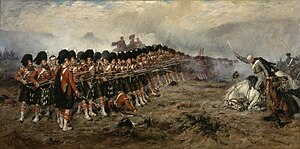The Thin Red Line (1854 battle)
| Thin Red Line | |||||||
|---|---|---|---|---|---|---|---|
| Part of Battle of Balaklava, Crimean War | |||||||
 The Thin Red Line, painted by Robert Gibb |
|||||||
|
|||||||
| Belligerents | |||||||
|
|
|||||||
| Commanders and leaders | |||||||
|
|
|||||||
| Strength | |||||||
| 550 British and Turkish forces | 400 Russian forces | ||||||
The Thin Red Line was a military action by the British Sutherland Highlanders 93rd (Highland) Regiment at the Battle of Balaklava on 25 October 1854, during the Crimean War. In this incident, the 93rd, aided by a small force of 100 walking wounded, 40 detached Guardsmen, and some Turkish infantrymen, led by Sir Colin Campbell, routed a Russian cavalry charge. Previously, Campbell’s Highland Brigade had taken part in actions at the Battle of Alma and the Siege of Sevastopol. There were more Victoria Crosses presented to the Highland soldiers at that time than at any other. The event was lionized in the British press and became an icon of the qualities of the British soldier in a war that was poorly managed and increasingly unpopular.
The Russian cavalry force of 2,500 was on the road to Balaklava. About 400 of them were involved in the incident. It was early morning, and the sole force that lay between the oncoming cavalry and the disorganised and vulnerable British camp was the 93rd Regiment.
Colin Campbell, 1st Baron Clyde is said to have told his men, "There is no retreat from here, men. You must die where you stand." Sir Colin's aide John Scott is said to have replied, "Aye, Sir Colin. If needs be, we'll do that." Campbell formed the 93rd into a line two deep — the "thin red line". Convention dictated that the line should be four deep. However, Campbell, a veteran of 41 years military service, had such a low opinion of the Russian cavalry that he did not bother to form four lines, let alone a square, but met the charge head on with the 2-deep firing line. As the Russian cavalry approached, the 93rd discharged three volleys: at 600, 350 and 150 yards respectively, however they did not get a chance to discharge one at point-blank (as at Minden in 1759) range as in popular belief. This is due to the fact that the Russian commander, seeing such a thin line of infantry, concluded that this was a diversion and that there was a much stronger force behind the 93rd, and ordered the cavalry to withdraw. At that, some of the Highlanders started forward for a counter-charge, but Sir Colin stopped them with a cry of "93rd, damn all that eagerness!"
...
Wikipedia
